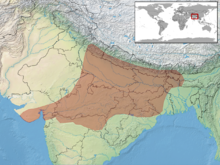Indian egg snake
| Indian egg snake | ||||||||||||
|---|---|---|---|---|---|---|---|---|---|---|---|---|

Indian egg snake ( Boiga westermanni ) |
||||||||||||
| Systematics | ||||||||||||
|
||||||||||||
| Scientific name | ||||||||||||
| Boiga westermanni | ||||||||||||
| ( Reinhardt , 1863) |
The Indian snake eggs ( Boiga westerwelle Manni , Syn. : Elachistodon westermanni ) is a snake of the genus boiga ( Boiga ) within the family of snakes . It was named after William Westermann, who collected the holotype in 1863 .
description
The Indian egg snake reaches a length of 84 cm. The elongated body is flattened laterally. The large eyes have perpendicular pupils. The top is dark olive brown to black. The scales on the center of the back along the spine (also known as the vertebralia) are yellow, except on their outer edges, where they form a bright vertebral streak that runs the length of the body. The underside is white. The outer edges of the ventral scales and the adjacent rows of scales are outlined in brown. A yellow stripe runs along the top of the head above the eyes from the muzzle to the corners of the mouth. A square spot can be seen on the neck. The lips are yellow.
Occurrence

Historical evidence comes from Terai , Bangladesh , West Bengal , Bihar and Uttaranchal . The most recent observations come from the Indian states of Maharashtra , Gujarat and Telangana .
Way of life
The Indian egg snake is non-toxic. It feeds on reptile and bird eggs. With the help of thorn-like projections (hypapophyses) on the wall of the esophagus covered with enamel, the eggs are swallowed and broken open. The contents of the egg are swallowed and the eggshells are choked out again.
status
From 1863 to 2003, only 8 specimens of the Indian egg snake were known. After the sightings did not take place from 1969 onwards, the species was thought to have been lost until Parag Dandge, district coordinator of the Satpuda Foundation in Wardha , Maharashtra , discovered a dead specimen in August 2003 that was partially eaten by ants. Unable to identify the snake, he preserved and photographed it and sent the images to the Center for Herpetology in Chennai , the Bombay Natural History Society (BNHS) and the Indian Herpetological Society (IPS) in Pune . In 2005, German and Indian taxonomists finally succeeded in identifying the specimen as an Indian egg snake. Between 2005 and 2007, the first living specimens were discovered in the districts of Amravati in Maharashtra and Bhavnagar in Gujarat . In 2014 there was the first evidence for the state of Telangana . The Indian egg snake is listed in the IUCN Red List as a least concern (not endangered) and in Appendix II of the Washington Convention on Endangered Species.
literature
- Carl Gans and Ernest E. Williams: Present knowledge of the snake Elachistodon westermanni Reinhardt . In: Breviora (Volume no. 1-66) (1952-1956). Harvard University. Museum of Comparative Zoology. ( Online )
- Tej Kumar Shrestha: Herpetology of Nepal: A Field Guide to Amphibians and Reptiles of Trans-Himalayan Region of Asia . Steven Simpson Books. 2000. ISBN 0-9524390-4-2
- Ashok Captain, Frank Tillack, Andreas Gumprecht and Parag Dandge: First Record of Elachistodon westermanni Reinhardt, 1863 (Serpentes, Colubridae, Colubrinae) from Maharashtra State, India. In: Russian Journal of Herpetology. Vol. 12, No. 2, 2005, pp. 121-123
Web links
- Satpuda Foundation Snake Considered to be Extinct Found in Maharashtra ( Memento August 4, 2007 in the Internet Archive )
- Boiga westermanni in The Reptile Database
- Elachistodon westermanni inthe IUCN Red List of Threatened Species 2013.2. Posted by: Srinivasulu, C., Srinivasulu, B., Vyas, R., Thakur, S., Mohapatra, P. & Giri, V., 2011. Retrieved January 5, 2014.
- A Snake Thought to Have Gone Extinct in 1969, Spotted in City